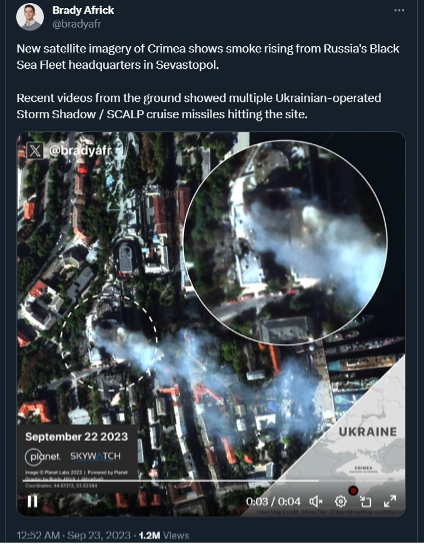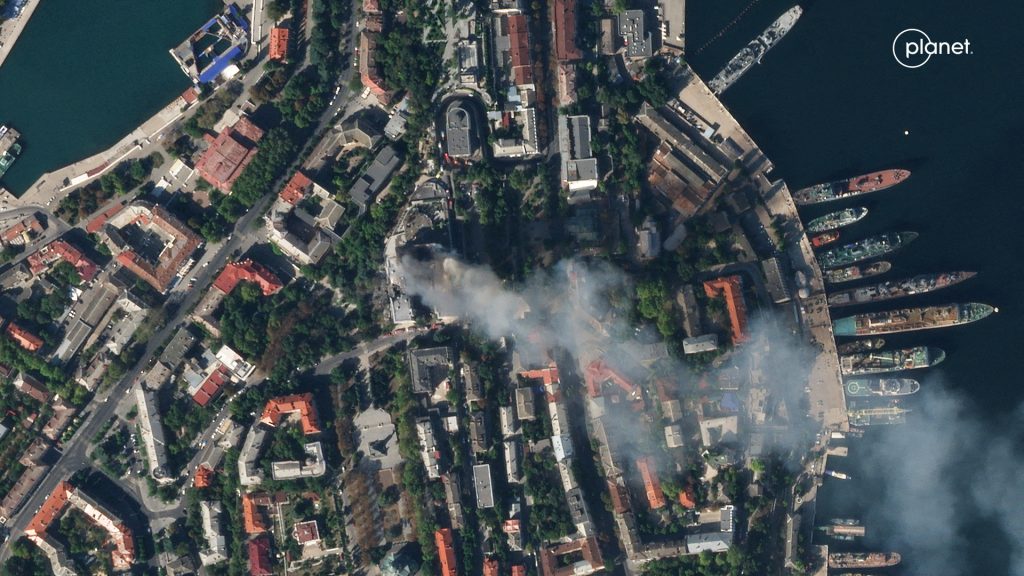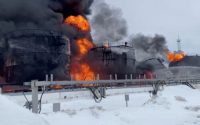
Russian War Report: Competing claims about the possible death of Russia’s Black Sea Fleet commander

As Russia continues its assault on Ukraine, the Atlantic Council’s Digital Forensic Research Lab (DFRLab) is keeping a close eye on Russia’s movements across the military, cyber, and information domains. With more than seven years of experience monitoring the situation in Ukraine—as well as Russia’s use of propaganda and disinformation to undermine the United States, NATO, and the European Union (EU)—the DFRLab’s global team presents the latest installment of the Russian War Report.
Security
Russian forces attack Ukrainian grain infrastructure
Russia’s missile attacks on Ukraine trigger border incident, raising security concerns in Moldova
Tracking narratives
Poland says pause in weapons shipments to Ukraine does not indicate a rift in relations
Attack on Black Sea Fleet headquarters in Sevastopol leads to questions about the potential death of fleet commander
Telegram posts shared on September 22 indicated that the Ukrainian armed forces struck the headquarters of Russia’s Black Sea Fleet in Sevastopol, occupied Crimea. In the following days, claims arose that the fleet’s commander, Russian Admiral Viktor Sokolov, had been killed. His death, however, remains an open question after Russia rejected the claims while offering inconclusive evidence.
On September 22, the Russian-installed governor of the occupied Crimean Peninsula, Sergey Aksyonov, said on Telegram that air defenses had intercepted cruise missiles. Sevastopol Governor Mikhail Razvozhayev posted an initial assessment reporting no civilian casualties. The Russian Ministry of Defense (MoD), however, said early on that one soldier had died as a result of the Black Sea Fleet headquarters being damaged in the shootdown. The Telegram post was later updated to state that “one serviceman did not die, he went missing.”
Videos posted to Ukrainian Telegram channels on the next day, September 23, documented what appeared to be several missiles striking the building. Planet.com satellite imagery shared on X (formerly Twitter) by open-source intelligence researcher Brady Africk showed a plume of smoke above the location of the headquarters the day prior.

Also on September 23, head of Ukrainiain military intelligence Kyrylo Budanov told Voice of America that at least nine people were killed and sixteen wounded, including Russian generals, in the attack; addressing reports of Sokolov’s death, Budanov declined to provide any information.
On September 25, local media outlet Новости Донбасса (“News of Donbas”) reported that Ukraine had claimed it had killed Sokolov in the September 22 strike on Sevastopol, though the article’s source, a Telegram post from the Ukrainian Special Operations Forces, did not support this report. On September 26, the Russian MoD released footage of Sokolov participating in a meeting remotely via video link. The date of the meeting, however, has not been confirmed, leaving open the possibility that it was old footage. In response, that same day, Ukraine’s Special Operations Forces issued a clarification in which they updated the casualty numbers—thirty-four Russian officers killed and 105 personnel wounded—and stated that they were looking into “the information” about Sokolov’s reported death.
On September 27, attempting to prove Sokolov’s survival, MoD-run Zvezda TV aired an interview with Sokolov at an award ceremony for the Black Sea Fleet’s soccer team. In a thread on X, Radio Free Europe/Radio Liberty reporter Mark Krutov pointed out that the same football team featured in the September 27 video also participated in a nearly identical award ceremony on September 20, as reported by local news. Indeed, Russian media outlet Vesti broadcast the ceremony on September 20.
In the same X thread, Krutov highlights that Sokolov was likely not in attendance on September 20, given that none of the footage from the event features him and that absence would have been strange if he had been in attendance. As such, Krutov then suggests that the ceremony was “re-enacted” on September 27. Seemingly confirming that Sokolov was not at the September 20 ceremony, in the Zvezda TV interview, Sokolov told journalists that his busy schedule delayed the September 20 ceremony.
In a post to its Telegram channel, which Krutov also points to, News of Donbas indicated that a computer monitor in the background of the interview seemed to show the date as September 27, though it was fuzzy.
Ultimately, at the time of writing, no conclusive footage has emerged of Sokolov directly debunking the claims of his death.
—Ruslan Trad, resident fellow for security research, Sofia, Bulgaria
—Valentin Châtelet, research associate for security, Brussels, Belgium
Russian forces attack Ukrainian grain infrastructure
Seven ships have left Odesa ports through the temporary Black Sea corridor, according to Dmytro Pletenchuk, spokesperson for the Ukrainian Naval Forces, as reported by Interfax on September 26. After Russia pulled out of the Black Sea Grain Initiative, it launched attacks on Ukraine’s grain infrastructure and threatened ships operating in Ukraine’s Black Sea maritime space, prompting Kyiv to divert exports through ports on the Danube River. Russian forces appear to be attempting to halt supplies by striking the ports of Izmail and Reni, risking an escalation on the Romanian border. In recent weeks, Ukrainian troops have hammered the capabilities of the Russian Black Sea Fleet, allowing ships to leave, albeit in small numbers, from the Odesa area. The DFRLab’s monitoring indicates that Ukraine’s Black Sea strategy is proving successful, so much so that Russia accused Ukraine’s Western allies of helping attack the Black Sea Fleet headquarters (as detailed above).
Elsewhere, a High Mobility Artillery Rocket System (HIMARS) strike hit a temporary command post in the occupied territory of the Kherson region during a meeting of Russian officers, Hromadske media reported on September 26. According to the same report, at least eight officers from Russia’s 70th Motorized Rifle Division were killed and seven injured. According to Ukrainska Pravda, Ukrainian forces struck the command post on September 18. Schemes (Skhemy), the Ukraine service of Radio Free Europe/Radio Liberty, reported that the HIMARS attack occurred in occupied Radensk, around thirty kilometers southeast of Kherson. On September 19, unverified reports from Russian sources claimed that strikes targeted the headquarters of the Russian 7th Airborne Division near Kherson, killing a significant number of officers.
Ukrainian forces continue offensive operations in the direction of Melitopol and Bakhmut. A Kremlin-affiliated military blogger claimed that Ukrainian troops had reached the northern outskirts of Novoprokopivka, though the claim is not yet confirmed.
—Ruslan Trad, resident fellow for security research, Sofia, Bulgaria
Russia’s missile attacks on Ukraine trigger border incident, raising security concerns in Moldova
On the night of September 25, the Russian military conducted drone strikes on Ukraine’s Odesa region using Shahed drones and Kalibr missiles, resulting in at least six fatalities and the destruction of grain infrastructure, including a seaport terminal and grain storage facilities. Following the strike, fragments of a missile were discovered in Chițcani village, located within the Moldovan-Transnistrian conflict security zone. On September 26, more missile fragments were found in a nearby field.
The press center of the separatist Ministry of Internal Affairs for the Transnistria region reported on the incident. According to Oleg Belyakov, the co-chair of the Joint Control Commission, on September 25, a significant explosion occurred over Transnistrian territory, leading to the discovery of missile debris in the garden of a private residence. According to his statement, the markings on the missile indicated that it was an S-300 missile manufactured in 1968.
The Moldovan Ministry of Defense has refrained from confirming the missile’s origin. Its official statement reads: “The source of the identified object remains unclear, and its trajectory lacks independent confirmation.” It added that military observers from the Joint Peacekeeping Forces have been deployed to the scene.
Chițcani is located near Moldova’s border with Ukraine, approximately ten kilometers from Tiraspol, the capital of the unrecognized republic of Transnistria. Since the beginning of Russia’s full-scale invasion of Ukraine, Moldovan authorities have reported multiple instances of Russian missiles violating Moldovan airspace. Missile remnants have been found on Moldovan soil on four occasions: October 31, 2022, near Naslavcea village; December 5, 2022, near Briceni town; January 14, 2023, in Briceni district; and February 16, 2023, near Larga village.
In April 2023, Moldovan Minister of Defense Anatol Nosatyi expressed concerns that Moldova faces “military threats” due to Russian shelling. On September 25, during his visit to Moldova, French Minister of Defense Sébastien Lecornu announced on X that Moldova plans to purchase the French GM200 air surveillance radar with financial assistance from the European Union. Additionally, he mentioned that France would be conducting an audit of its air defense capabilities to help improve Moldova’s airspace security.
—Victoria Olari, research associate, Moldova
Poland says pause in weapons shipments to Ukraine does not indicate a rift in relations
On September 20, Polish Prime Minister Mateusz Morawiecki stated that Poland was “no longer transferring weapons to Ukraine because we are now arming Poland.” He added that Poland was still ready to support Ukraine to defend it from Russian aggression. Morawiecki has not elaborated on whether this decision was connected to the current dispute between Ukraine and Poland over grain exports.
A number of international media outlets, however, framed the decision as being motivated by the grain dispute with Ukraine. For example, Al Jazeera reported, “Poland to halt supply of weapons to Ukraine as grain dispute grows;” CNBC reported, “Poland has said it will no longer supply its neighbor Ukraine with weapons, as a rift over agricultural exports deepens;” and The Guardian reported, “Poland will no longer send weapons to Ukraine, says PM, as grain dispute escalates.”
Representatives from the Polish government and diplomatic missions clarified Morawiecki’s statement. Marek Magierowski, ambassador of Poland to the United States, said on X, “No, @MorawieckiM never said ‘Poland will stop supplying weapons to Ukraine.’ This is a blatant distortion of his remarks.” His tweet clarifies that Morawiecki’s statement was intended to convey that Poland is temporarily pausing weapons shipments. He added, “over the last 17 months we have basically gutted our military for the sake of Ukraine’s war effort. Poland is now striving to make up for the depletion of our own capabilities.” Magierowski also penned an op-ed for the Wall Street Journal providing more context for the decision and saying claims that Poland is anti-Ukraine are “farcical.”
On September 21, government spokesman Piotr Müller said that currently Poland is only fulfilling its deliveries for previously signed contracts to supply ammunition and armaments to Ukraine. It remains unknown when those contracts expire. The following day, Polish Foreign Minister Zbigniew Rau published an opinion piece in Politico.eu in which he endeavored to separate the issue of grain supplies from that of equipping Ukraine, stating “There’s absolutely no contradiction here. Supporting Ukraine against Russia’s invasion and protecting our citizens and safeguarding them against unfair economic competition—both serve Poland’s interest simultaneously.”
In a September 25 interview with Polish outlet Super Express, Polish President Andrzej Duda attempted to defuse the tension, directly stating that Poland has “no problem” sending Ukraine older weapons as they are replaced by newer acquisitions.
—Givi Gigitashvili, research associate, Warsaw, Poland
Image: A satellite image shows smoke billowing from a Russian Black Sea Navy HQ after a missile strike, as Russia’s invasion of Ukraine continues, in Sevastopol, Crimea, September 22, 2023. PLANET LABS PBC/Handout via REUTERS THIS IMAGE HAS BEEN SUPPLIED BY A THIRD PARTY. NO RESALES. NO ARCHIVES. MANDATORY CREDIT. DO NOT OBSCURE LOGO


